

PRESTON SAMPSON

PRESTON SAMPSON
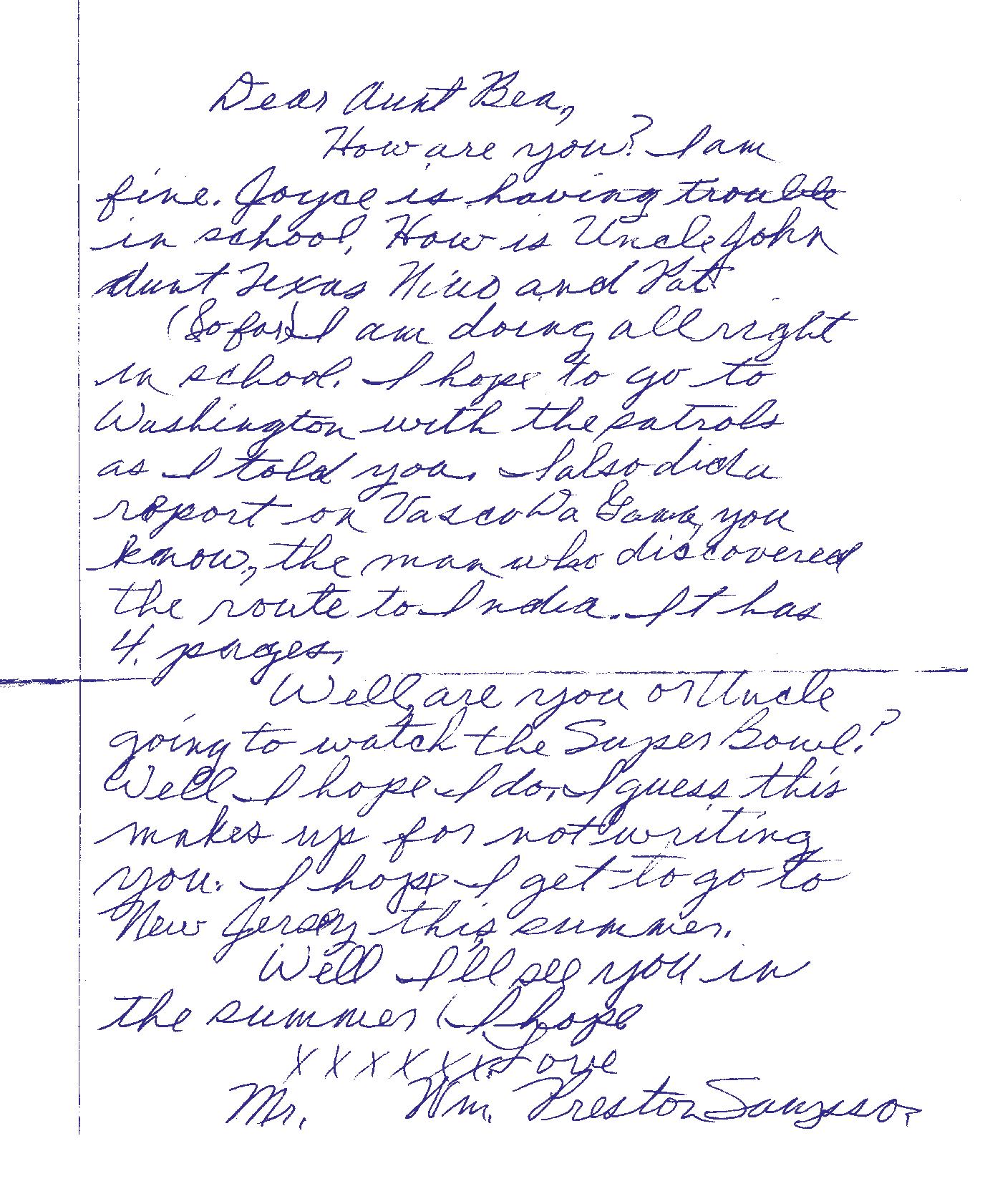


GREGORY W. FOWLER, PhD PRESIDENT
UNIVERSITY OF MARYLAND
GLOBAL CAMPUS
On behalf of the University of Maryland Global Campus (UMGC) community and the more than 95,000 learners we serve each year, I am pleased to welcome you to a special exhibition—Preston Sampson: Letters from Home.
Sampson launched his career as an artist more than four decades ago after graduating from our sister institution—University of Maryland, College Park—with a bachelor’s degree in studio art. His work has gained international renown for its mastery of color across a variety of media and for the unique perspectives in his depictions of family, friends, Black culture, and society as a whole. These works now feature in public and private collections across the country and around the world.
In addition to his work as an artist, Sampson is a sought-after public speaker and workshop host who has held residencies regionally and nationally and served as curator for a variety of exhibitions. His service as an art teacher for more than a decade in the District of Columbia public school system is especially meaningful, given UMGC’s mission to inspire hope, empower dreams, and transform lives . . . one student at a time.
As you view this remarkable exhibition, I hope you come away as inspired as I am by the perspective, vision, and ideas on display, which serve to remind us of the power within us to teach and learn—and in doing so, to build a better, more vibrant world.
Thank you for joining us at this thought-provoking exhibition and for your continued support of the arts and our UMGC Arts Program.
PHOTO BY KATHERINE LAMBERT
Director’s Statement
ERIC KEY DIRECTOR, ARTS PROGRAM UNIVERSITY OF MARYLAND GLOBAL CAMPUS
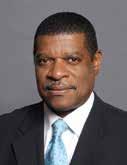
Preston William Sampson III (b. 1960) has worked in the trenches creating art for as long as he can remember. Art was in his household growing up: his father and one of his sisters drew, and they taught him to do the same. He remembers an absence of African American figures in the art world, but he also remembers his mother cutting out images of African Americans by other artists and hanging those works in the home. This family practice made Sampson determined to tell stories of the African American experience and include African American representation in his work.
Sampson realized he had a talent for making art in high school. He spent much of his time drawing in English class, and his English teacher, Peggy Phillips, would often show the other students his drawings, remarking that they could be as talented if they would apply themselves as Sampson did. Recognizing his talent, she introduced him to a graphic artist she knew. That artist also encouraged him, but it was Ms. Phillips who told him that he had a talent and that he could make money from his art.
From that day on, Sampson has followed an artist’s path. After graduating from high school, he moved to Maryland to attend University of Maryland, College Park (UMCP). There he met other artists who not only taught him different artistic techniques but mentored him. These artists included the eminent David Driskell, Patrick M. Craig, Jim Forbes, and Rhonda Williams. Sampson graduated from UMCP in 1984 with advanced knowledge and skills for creating art.
Over the years, Sampson has taught art in elementary school, high school, and community colleges and participated in community programs such as the Neighborhood Arts Academy in Washington, DC. When he decided to leave his teaching career, he knew the next chapter in his life was to focus on creating art. As with most dedicated artists, he is consumed by art. He surrounds himself with plans for the next work in the midst of completing his current work. He is up late in his studio and up early to advocate for art, artists, and the art industry.
The exhibition Preston Sampson: Letters from Home is a journey of reflection on Sampson’s life and experiences through art. Each work is a pictorial representation of some part of his life—his family, with their ups and downs, successes, and strength, and his community, including church and athletic and musical events. His works are colorful, mystical yet direct, and thoughtful. Through his art, Sampson tells us about what is important to him. The UMCG Arts Program is honored to share with you these moments in the life of Preston Sampson.
PHOTO BY TRACEY BROWN

TRESTON SANDERS
CURATOR, ARTS PROGRAM
UNIVERSITY OF MARYLAND
GLOBAL CAMPUS
Preston Sampson is a significant voice in contemporary art, his diverse practice encompassing painting, pulp painting, encaustics, and printmaking. A native of Florida with a fine arts degree from University of Maryland, College Park, Sampson crafts dynamic compositions that appeal to both domestic and international audiences and are found in esteemed public, private, corporate, and institutional collections.
Sampson orchestrates his compositions with a masterful command of hue and tone; his prints resonate with carefully considered chromatic relationships. His energetic approach serves as a visual analogue to his deep passion for jazz. The viewer can feel a palpable sense of rhythm and movement. Indeed, some of his most exuberant works can be understood as expansions of melodic ideas translated into visual harmonies and improvisational gestures.
Sampson focuses his creative attention on figurative portrayals, aiming "to emote, to touch, to move you to the center of it all, to enable you to feel certain changes, like fleeting moments of memory." His artistic intention is deeply rooted in creating an immediate and visceral connection with the viewer.
A powerful example of Sampson's narrative ability lies in his compelling series dedicated to Negro Leagues baseball. Richly textured mixed-media collages vividly recall the energy and excitement surrounding teams such as the Pittsburgh Homestead Grays, the New York Black Yankees, and the Birmingham Black Barons. In these works, Sampson not only documents a crucial chapter in American history but also ensures that the baseball players’ stories continue to reach new viewers. His mastery of his chosen mediums allows him to evoke the emotional weight of an era.
PHOTO BY TRACEY BROWN
PRESTON SAMPSON: THE COLOR OF KINSHIP
by Adrienne L. Childs, PhD Art Historian, Curator, and Author
Prolific and passionate, Preston Sampson is a painter’s painter, an artist’s artist. He is a creative who builds no boundaries between art and life and recognizes no borders between history and the present. Sampson’s superpower is his mastery of color, and the figure is his enduring subject. In many ways, Sampson’s work harkens back to a different era. It abounds with images of men in fedora hats and vintage suits. Sensuous women who channel old Black Hollywood dance across his canvases. But the humans who populate Sampson’s tableaux are not just stylish types; they are his friends and loved ones, past and present. They are icons of Black history who represent achievement, resistance, and the beautiful resilience of African

American culture. Across countless surfaces, from canvas to handmade paper, Sampson crafts stories that explore the shared experiences of African Americans and lovingly mine his family lore. Sampson’s creative conversation with the continuum of Black life in America is an approach that situates him as an inheritor of the New Negro movement and Harlem Renaissance sensibilities that emerged in the early 20th century. In 1925, Alaine Lock published the anthology The New Negro, which articulated the important role of the arts in the urgent project of representing Black life and history. In the face of epic social challenges for African Americans, the movement emphasized self-definition through the arts as a form of both resistance and nourishment. The essential role of the visual arts in Black cultural and political formations has continued unabated. Indeed, 100 years after the New Negro movement called artists to embrace creativity as a form of collective uplift, Preston Sampson: Letters from Home celebrates an artist who has carried that tradition dynamically into the 21st century.
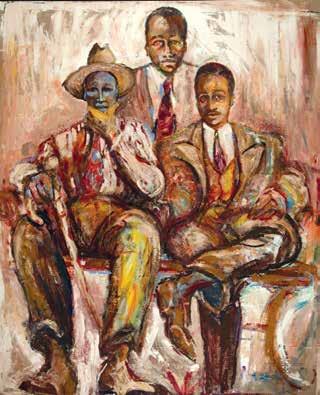
Fig. 1. Origin, 1978, oil on canvas, 10½ x 8½ in.
Fig. 2. Legacy, 1999–2000, acrylic on linen, 90 x 80 in., Collection of the Washington (DC) Alumni Chapter of Kappa Alpha Psi Fraternity

Family Men
Sampson was born and raised in Pleasant City, a historic African American community in West Palm Beach, Florida. Aptly named, Pleasant City was a small, segregated enclave of working-class Black families that felt like a safe, supportive, and even idyllic place to grow up. Sampson writes, “It was a community of fierce pride, dignity, achievement, and swagger, all against the backdrop of social distress and desegregation.”1 Sampson’s formative years spent in this family-oriented town with his two parents and three older siblings had a lasting impact. The youngest and the only male, Sampson is the third Preston, the namesake of his paternal grandfather, Preston the first, whom he never knew. This patrilineal ancestry looms large in Sampson’s work and is a driving force behind many of the stories he tells. In fact, Preston the first became his grandson’s muse—the spirit behind the archetypical Black man who is Sampson’s constant refrain. In the 1978 painting Origin (fig. 1), Sampson fashions a composite figure driven by the idea of his grandfather, perhaps even drawing on cellular memory. Origin was the first oil painting Sampson completed during his undergraduate studies at University of Maryland, College Park. Remarkably, it remains the seed from which Sampson’s nearly 50-year practice springs.
“It was a community of fierce pride, dignity, achievement, and swagger, all against the backdrop of social distress and desegregation.” —PRESTON SAMPSON
Sampson’s young painterly hand applied muted tones to Origin, recalling faded family photographs. The solemn portrait of a man wearing a suit and tie with a wide-brimmed hat dipping stylishly to his left that germinated in Origin is Sampson’s signature composition, an ancestral icon that appears in countless other paintings that followed. This figure resurfaces in group portraits such as Legacy (fig. 2), in which Sampson pays tribute to his forefathers and the essential beauty and strength of Black men.
A critical mass of Sampson’s work unapologetically tells the stories of Black men—all kinds of Black men. Old men in hats. Young men with swagger. Athletes, soldiers, waiters, presidents, poets, musicians, fathers, martyrs, dandies, and more. Prominent in Sampson’s ongoing project to uplift the image of the Black male are depictions of working men. Sampson states:
Behind every PhD, lawyer, and entrepreneur, there is a man in the background with dirt under his fingernails. A shirt with a name tag, no fanfare, almost invisible to the privileged, merely someone doing his bidding. In other words, he is the backbone of America, the man who sacrificed and labored to send the first in his family to college. An American hero.2
The etching with chine collé The Craftsman (fig. 3) celebrates the skilled workmanship of two builders who are able to create structures with their hands and tools. The central figure, depicted with muscular arms, is captured carving wood, while the man in the background saws a plank. Sampson’s
Fig. 3. The Craftsman, 2007, etching, 15 x 15 in., UMGC Permanent Collection, Maryland Artist Collection, Produced by Millennium Art Salon, Gift of Juanita Boyd Hardy



expressive draftsmanship adds movement and energy to the composition. In the 2007 pulp painting Holding the Line (fig. 4), Sampson’s working man literally holds a rope as he metaphorically holds the line for his family and community. Sampson’s use of line, vivid color, and focus on the laboring Black body reflects the influence of Charles White and Jacob Lawrence—two of Sampson’s art heroes and towering figures in the history of American art. The powerful arms and large hands of the men in Lawrence’s 1991 lithograph Builders Three (fig. 5), for instance, speak to the strength and dignity of work and of Black working men. These sentiments are echoed by Sampson in The Craftsman, Holding the Line, Moving Wood (fig. 6), and countless other works. Sampson’s intergenerational dialogues with Lawrence, White, and others are an artistic repartee that has become a critical aspect of his process. Important figures in African American history appear throughout Sampson’s body of work.
Clockwise from top left: Fig. 4. Holding the Line, 2007, mixedmedia pulp painting, 30 x 22 in., Collection of George Martin; Fig. 5. Jacob Lawrence, Builders Three, 1991, lithograph on Arches paper, 30 x 21¾ in., Courtesy of DC Moore Gallery, New York, © 2025 The Jacob and Gwendolyn Knight Lawrence Foundation, Seattle/Artists Rights Society (ARS), New York; Fig. 6. Moving Wood, 2006, mixed media on pulp paper, 30 x 40 in., UMGC Permanent Collection, Maryland Artist Collection, Gift of the artist


The poet Langston Hughes in his waiter’s uniform is featured in Langston Blues (fig. 7). While the painting is not a portrait of Hughes, it is based on a well-known 1925 photograph of the poet working in a Washington, DC, hotel (fig.8). Here Sampson’s interest in celebrating the working man meets his ongoing conversation with the luminaries of Black history. There is perhaps no greater luminary than Frederick Douglass, who escaped slavery in the 19th century and became an abolitionist. In Created Equal (fig. 9), Sampson’s Douglass, dressed in a colorful suit, is seated in the Lincoln Memorial’s monumental chair. Against the backdrop of an American flag, a heroic Douglass looms large while a young boy gazes up at him. Again, Sampson explores the importance of intergenerational learning and respect connecting the experiences of today’s Black youth to the social justice crusades of major historical figures like Douglass.

Clockwise from left: Fig. 7. Langston Blues, 2006, pulp painting and mixed media on handmade paper, 30 x 40 in., Collection of Kendrick Ashton; Fig. 8. Langston Hughes working as busboy in Washington, DC, 1925, photograph, Underwood Archives, Inc./ Alamy Stock Photo; Fig. 9. Created Equal, 2022, hand-embellished digital print, 40 x 30 in.
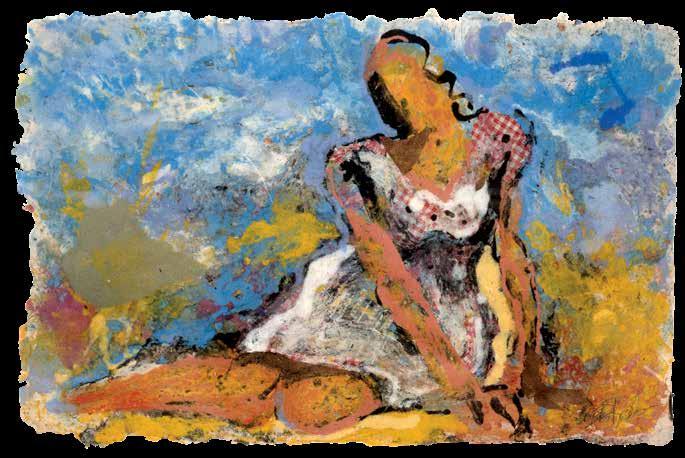
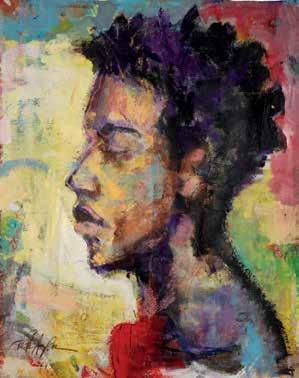

Fig. 10. Repose, 2011, mixed media on pulp paper, 22 x 30 in., Collection of Piero and Christie Novelli
Fig. 11. Big Top with Natural Crown, 2017–18, mixed media on canvas, 38 x 30 in.
Fig. 12. Sam Gilliam, Sierra, 1972, acrylic on shaped canvas, 541/4 in. x 501/4 in., Courtesy of the Phillips Collection, Washington, DC, © 2025 Estate of Sam Gilliam/Artists Rights Society (ARS), New York
The Color and Texture of Style
Leisure pursuits, sports, and the joyous connections between everyday people are celebrated in Sampson’s expansive view of Black life. With a nod to the idyllic pastorals of Henri Matisse, the mixed-media work Repose (fig. 10) features a woman reclining amid an abstract riot of pigment. For me, this work imagines a woman of color as an allegory of nature and beauty—fully deserving of repose. It also offers a healing gesture that counters destructive tropes of the Black woman as a solely laboring or even primitive body.
Repose is as much a meditation on the beauty of women of color as it is an exploration of color and texture, which are paramount features of Sampson’s practice. As a graduate student at the University of Maryland, College Park, Sampson worked with professors and mentors David C. Driskell and Sam Gilliam, who were both master colorists. Driskell’s and Gilliam’s vivid jewel tones continue to thrive in Sampson’s work. While Sampson is an avowed figurative painter, he was deeply influenced by Gilliam’s immersive and expressive abstraction. The gestural interplay of color and texture encompassing works such as Repose and Big Top with Natural Crown (fig. 11), among many others, recalls works by Gilliam, such as the 1972 painting Sierra (fig. 12). Indeed, Sampson’s 2024 untitled abstraction (fig. 13) beautifully reflects the Gilliam inheritance.
In 1997 Sampson was inadvertently introduced to pulp-painting techniques, and they afforded his love affair with color and abstraction new possibilities. Pulp painting describes a method of building an image with pigmented wet pulp (the fibrous wet material out of which paper is made) before it dries. The result is a textured work in which the image is not on the surface but built into the paper. For Sampson, the fluidity of the process provides a dynamism of its own. The way the pigments move through the pulp and blend together is beyond his absolute control. The element of surprise and the ability to layer saturated color intrigues him and has kept him excited by the medium for two decades.
In many of Sampson’s pulp paintings and other works, men and women of dignity and style
“Leisure pursuits, sports, and the joyous connections between everyday people are celebrated in Sampson’s expansive view of Black life.”
—ADRIENNE L. CHILDS
are some of his most enduring characters. I use the term characters deliberately because Sampson often states that he is a narrative painter, a griot of sorts. While there is always a backstory behind each figure, drawn from Sampson’s own experiences, encounters, and memories, the figures are recognizable and relatable to viewers of all stripes. The cool and collected woman and man pictured
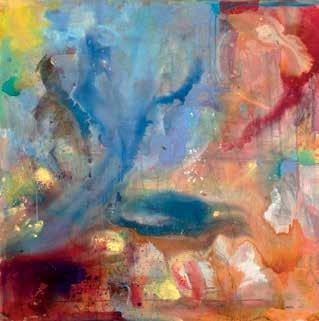
Fig. 13. Untitled (Abstraction), 2024, mixed media on canvas, 48 x 48 in.

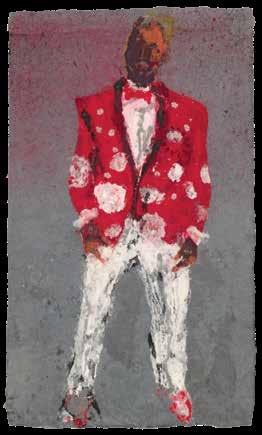

Clockwise from left: Fig. 14. Class, 2024, pulp-painting collage, 61 x 33 in., Collection of Brenda Atkinson-Willoughby; Fig. 15. Dignity, 2024, pulppainting collage, 61 x 33 in.; Fig. 16. Home Boy Ralph, 2020, mixed-media pulp painting, 41 x 23 in., Collection of the artist
respectively in Class and Dignity (figs. 14–15) embody Sampson’s penchant for familiar characters with style and swagger. Class and Dignity are fashioned in his pulp-paper technique with collaged textiles that include an African fabric in the man’s tie. Here Sampson points to the way Black style seamlessly incorporates diasporic identities. Sampson’s males can be considered dandies. Dandyism—or the performative affectation of style, refinement, and elegance adopted by some men— has been a fascinating aspect of Black male selffashioning for centuries.3 Black dandies embody Sampson’s vision of the depth, breadth, authenticity, and joy of Black style. His images are teeming with Black dandies, including family, friends, and wholly fictitious characters. Home Boy Ralph (fig. 16) is a case in point. Sampson portrays Ralph full-length wearing white pants and shirt with a red-and-white blazer accented by a red bow tie. Cutting quite the figure, Ralph communicates a youthful confidence and attitude with his wide-legged stance. Sampson recalls that Ralph was a friend from his childhood
in Pleasant City. He remembers Ralph as an “openly gay man when it wasn’t cool, but every brother in the hood gave him respect and just treated him as another homeboy.” For Sampson, memories of Ralph represent the inclusive spirit of his community, even in the 1960s.
For Black men, dress and style can signal both personal expression and a form of resistance to entrenched degrading stereotypes. Black social, cultural, and political standing can be asserted through style in creative ways. In Hero’s Welcome (fig. 17), the “hero” wears an army uniform. His figure emerges from undulating dabs of color that come together organically in the pulp-painting process. Visible through the color clouds are small “pickaninny” figures—degrading stereotypes of Black babies that were popular in Jim Crow America. These kinds of insulting images, which permeated popular culture in the early 20th century, were deployed to denigrate African Americans who struggled for advancement. Here Sampson asks us to consider the patriotism of Black soldiers who often sacrificed for the nation against a backdrop of injustice.

Social and Personal Justice
As an astute chronicler of Black life in America, Sampson has been keenly aware of the perilous environment that young Black men have had to navigate both historically and in our time. Contemplating one of the most egregious chapters of racial injustice in our recent history, Sampson created a series of portraits as an homage to the unjustly accused and incarcerated young Black men dubbed the Central Park Five. Oh Say Can You See (fig. 18) depicts one of the accused in a mug shot–like portrait. “NYCPD” and “MAGA” are stamped across the front of the painting. Of course, the New York City Police Department was responsible for the ultimate wrongful imprisonment of these men.
“MAGA” refers to the political movement incited by Donald Trump when he ran for president in 2016, 2020, and 2024. Notoriously, Trump had placed an advertisement in the New York newspaper Newsday in 1989, calling for the execution of the Central Park Five. Here, Sampson is collapsing

Fig. 17. Hero’s Welcome, 2024, mixed-media pulp painting, 23½ x 19 in.
Fig. 18. Oh Say Can You See, 2020, acrylic on canvas, 40 x 30 in.
time: connecting the rhetoric of making America great again—as called for in Trump’s 21st-century slogan “MAGA”—to the imprisonment of the young Black men for whom Trump called for the death penalty in 1989. The fact is that by the 2020s when Sampson embarked on this series, the nation had seen innumerable unjustified incarcerations and killings targeted at young Black men. Sampson’s portraits of all five young men speak backward and forward in time.
In recent years, Sampson has embarked on his Documents Please series—one of his most personal bodies of work. In the course of doing family research, Sampson’s sister Joyce uncovered family documents previously unknown to him. They reveal an astonishing chapter of their family history. The artist's great-uncle Morris M. Sampson, born in 1834, rose to become a justice of the peace in Madison County, Florida, in 1874. This was a major achievement for a Black man in the Reconstructionera South. Yet, among the unrest in the county, Morris Sampson was lynched in the mid-1880s. While it is impossible to reconcile this devastating history, Sampson mines the wrenching contradiction between uplift and oppression through a series of works in which he creates multimedia portraits of his ancestral icon and incorporates his family documents into the work. In Chronicle of Morris (fig. 19), Sampson creates a generalized portrait of Morris Sampson, a Black man with strong White and Native American features. Wearing the signature tilted fedora, Sampson’s archetypical ancestor is dappled in yellows, pinks, oranges, and light blues. Through the paint, we can see traces of the 1874 certificate naming Morris Sampson a justice of the peace for Madison County. The beauty of the figure and the accomplishment represented by the certificate are tempered by our understanding of the horrific demise Morris Sampson suffered. Here Sampson accepts and represents the whole of the story—recognizing that Black life in America is replete with these histories of trauma and beauty. Yet through his art, Sampson remains optimistic. He states, “Agents of hate and divisiveness are at the helm, and yet, we remain resolute with hope and pride and beauty.”4 Hope, pride, and beauty are indeed Sampson’s winning cocktail.
Preston Sampson: Letters from Home brings together a kaleidoscope of works produced over decades. They are a testament to a politically, socially, and aesthetically engaged artist who paints with love and passion from his heart and home.
Adrienne L. Childs, PhD, is an award-winning art historian and curator. She received her doctorate from University of Maryland, College Park, and is the former curator of the David C. Driskell Center. She is currently the senior consulting curator at the Phillips Collection.
1 Preston Sampson statement in Lynn Sures and Michelle Samour, Radical Paper: Art and Invention with Colored Pulp (Legacy Press, 2024), 217.
2 Artist statement, 2025.
3 See Monica L. Miller, Slaves to Fashion: Black Dandyism and the Styling of Black Diasporic Identity (Duke University Press, 2009).
4 Artist statement, 2020.

Fig. 19. Chronicle of Morris, Documents Please series, 2024, pulp-painting collage, 34 x 25 in.


Self-Portrait, 1978, gouache on board, 193/8 x 67/8 in.
PRESTON SAMPSON

Miami Dolphins, 1970s, paint on wood, 8¾ x 10 in.
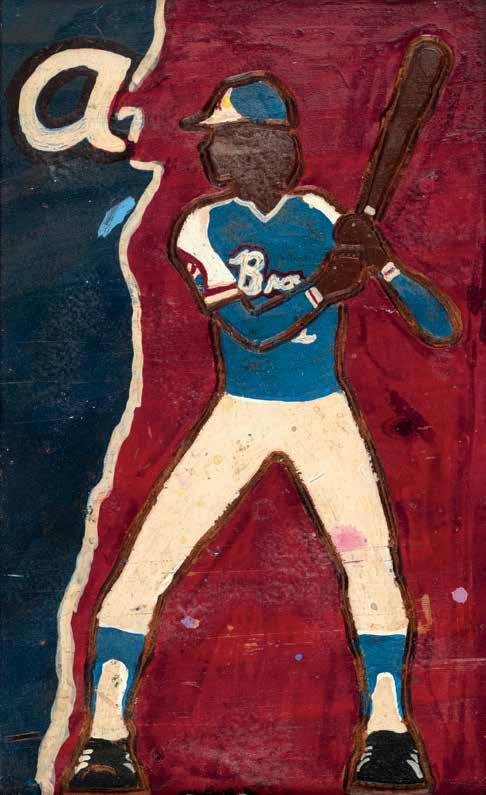
Untitled (Baseball Player), 1970s, paint on wood, 11¾ x 7 in.

Guardian, n.d., encaustic on wood, 12 x 12 in., Collection of Lynn Sylvester

Gabriel, 1984, mixed media, 50 x 50 in., Collection of Curtis and Leslie Lewis

Goddess of Mango Season, n.d., mixed media on canvas, 43 x 70 in., Collection of James and Terri Scott
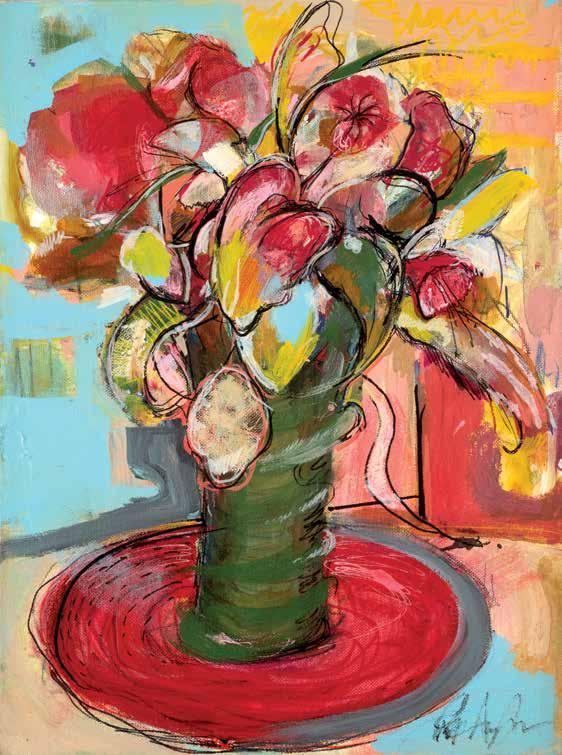
Floral Fantasy, n.d., acrylic on canvas, 16 x 12 in., Courtesy of Just Lookin’ Gallery

Golden Child, 2022, acrylic on canvas, 40 x 30 in.

Prodigies, 2005, acrylic on canvas, 46 x 70 in., Collection of Larry Frazier

Fork in the Road, 2018, mixed media on paper, 41 x 32 in.
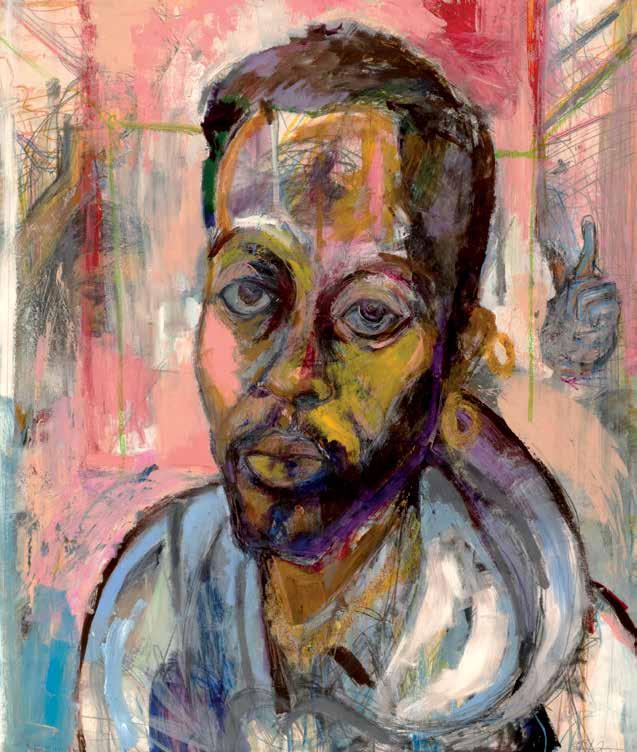
Pink Floyd, 2018, mixed media on paper, 50 x 41 in.

Sybil, 2023, pulp painting, 45 x 23 in.

Sunday Best, 1992, acrylic on stetched canvas, 38½ x 50¾ in., The David C. Driskell Center at the University of Maryland, College Park, Gift from the Sandra and Lloyd Baccus Collection, 2012.13.174
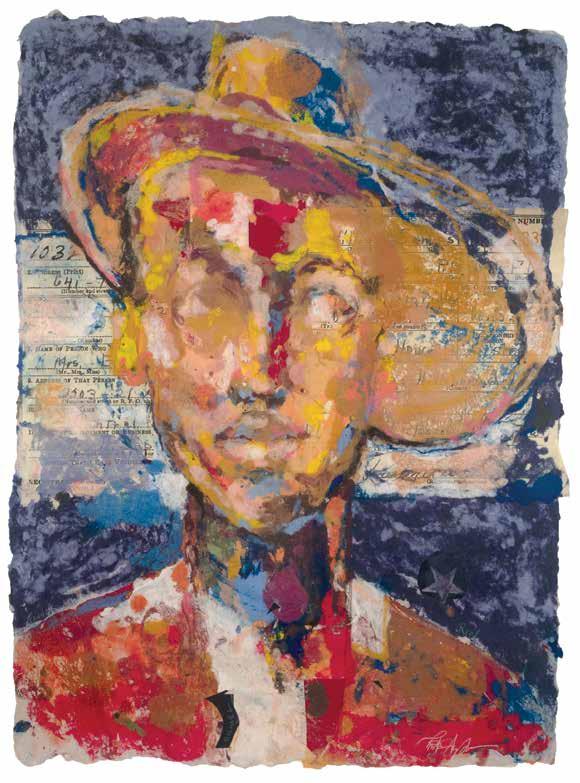
Bearer of Secrets, Documents Please series, 2024, pulp-painting collage, 34 x 25 in.

Documented, Documents Please series, 2024, pulp-painting collage, 34 x 25 in.

Man Playing Guitar, 2005, watercolor on pulp paper, 41¾ x 49½ in., Collection of Eric Key

Repose, 2011, mixed media on pulp paper, 22 x 30 in., Collection of Piero and Christie Novelli

Brothers, 2022, mixed media on canvas, 48 x 60 in.
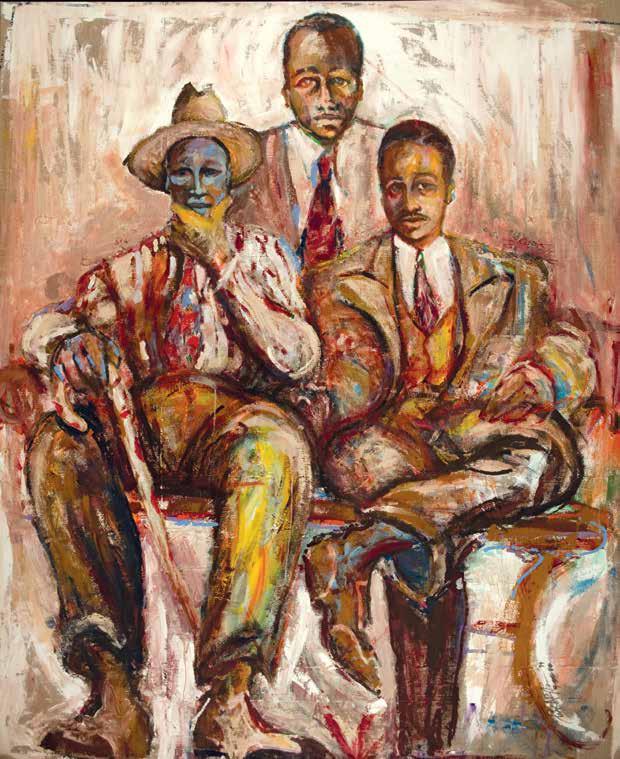
Legacy, 1999–2000, acrylic on linen, 90 x 80 in., Collection of the Washington (DC) Alumni Chapter of Kappa Alpha Psi Fraternity
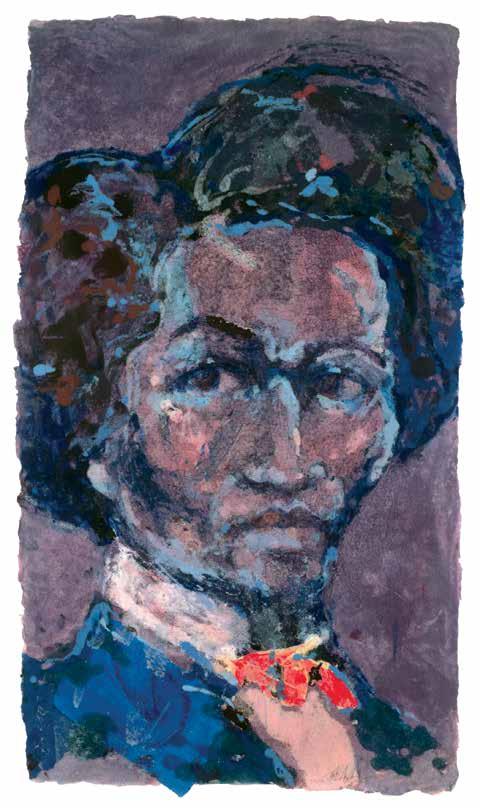
Lion, 2022, pulp-painting collage, 40½ x 23½ in., Collection of Moses Sawney

Created Equal, 2022, hand-embellished digital print, 40 x 30 in.

Scribe, 2024, mixed-media pulp painting, 32 x 23½ in., Collection of Stephen Keith/Courtesy of Just Lookin’ Gallery
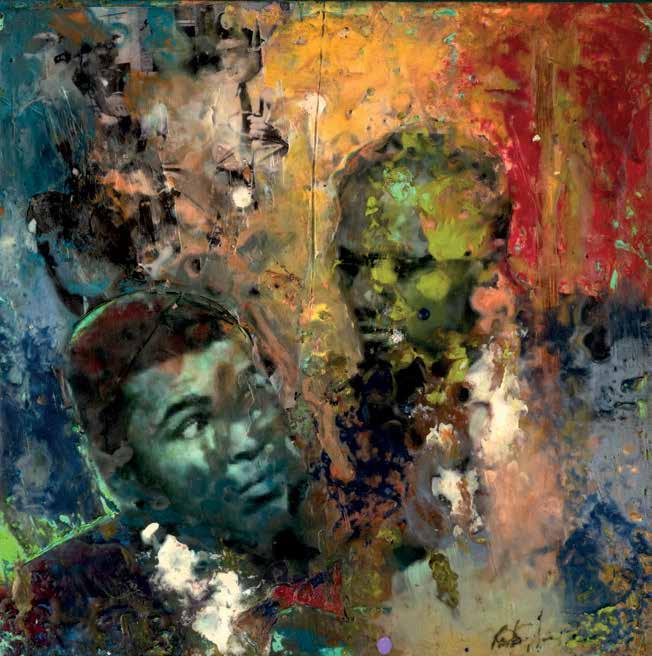
Good Counsel, 2012, encaustic on foam board, 11 x 11 in.
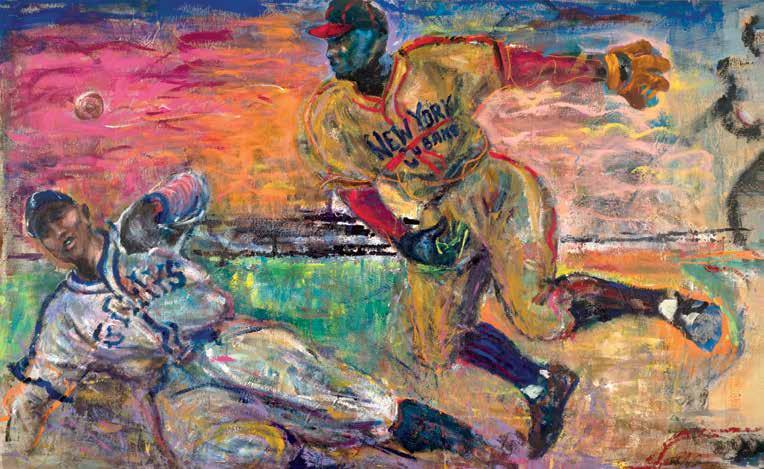
Turning Two, 1990, acrylic on linen, 44 x 70 in., Collection of Curtis and Leslie Lewis

Maroon Devils, 2023–25, mixed media on canvas, 90 x 94 in.

Patriot Game, 2024, mixed media on paper, 41 x 23½ in.

Chronicle of Morris, Documents Please series, 2024, pulp-painting collage, 34 x 25 in.
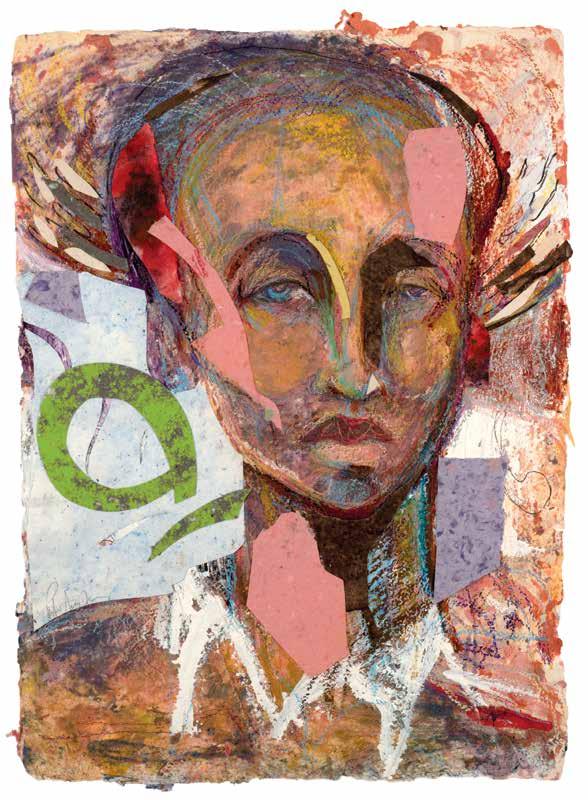
Modern Man, 2007, mixed-media collage on paper, 30½ x 21½ in., Collection of Neil and Juanita Hartbarger

Moving Wood, 2006, mixed media on pulp paper, 30 x 40 in., UMGC Permanent Collection, Maryland Artist Collection, Gift of the artist
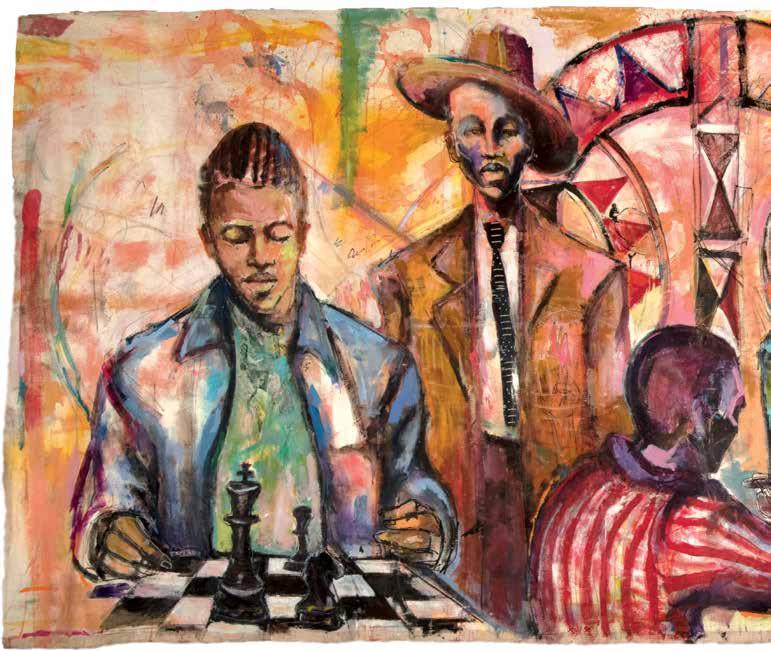

Long Game for Morris, 2022, mixed media on canvas, 60 x 141 in.

Dignity, 2024, pulp-painting collage, 61 x 33 in.

Class, 2024, pulp-painting collage, 61 x 33 in., Collection of Brenda Atkinson-Willoughby
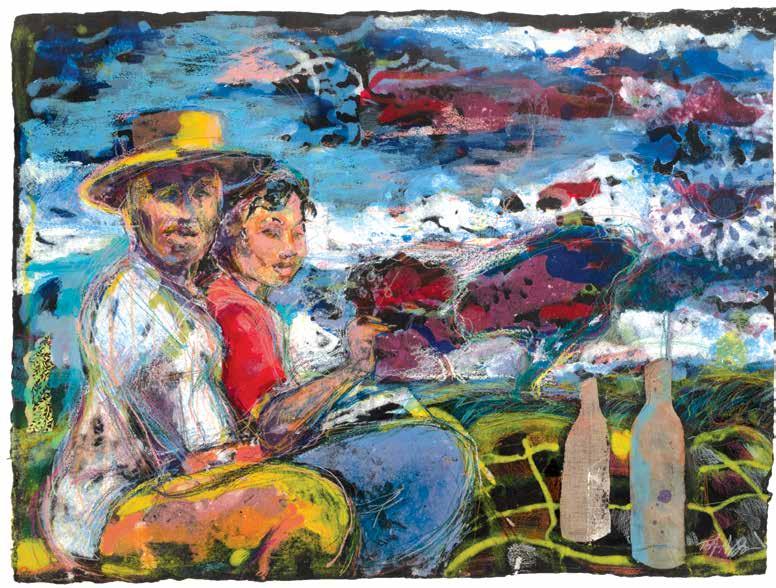
Love Is Everywhere, 2023, mixed-media pulp painting, 24 x 32 in., Collection of Brenda and Larry Thompson

Man in Blue Hat, n.d., mixed-media pulp painting, 38 x 30 in., Collection of Eileen Berger/Just Lookin’ Gallery
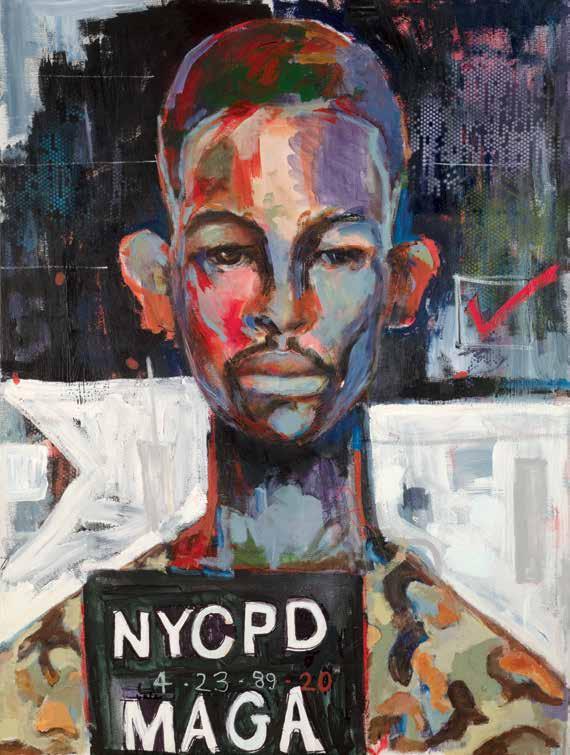
Oh Say Can You See, 2020, acrylic on canvas, 40 x 30 in.

Hero’s Welcome, 2024, mixed-media pulp painting, 23½ x 19 in.

Prodigal Son, 2019, acrylic on canvas, 40 x 30 in.

Prince of the City, 2019, mixed media on canvas, 38 x 26 in., Collection of Clarence Reynolds

Graduation Day, 1987, acrylic on canvas, 21 x 16 in.
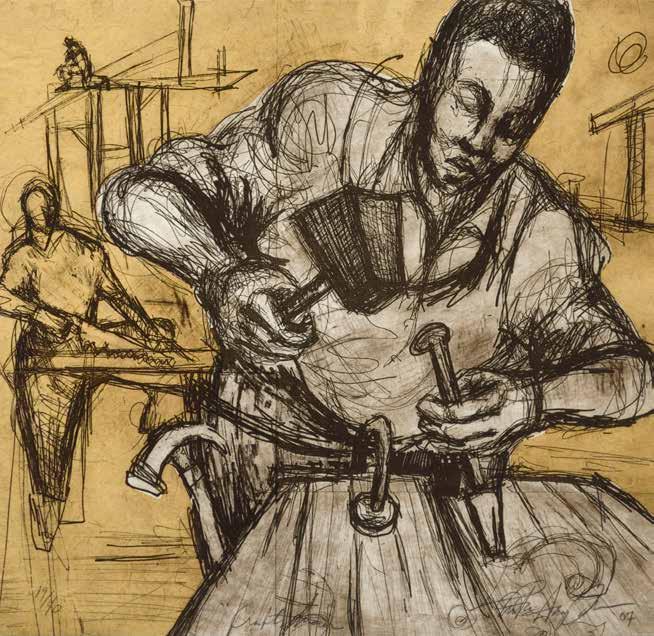
The Craftsman, 2007, etching, 15 x 15 in., UMGC Permanent Collection, Maryland Artist Collection, Produced by Millennium Art Salon, Gift of Juanita Boyd Hardy
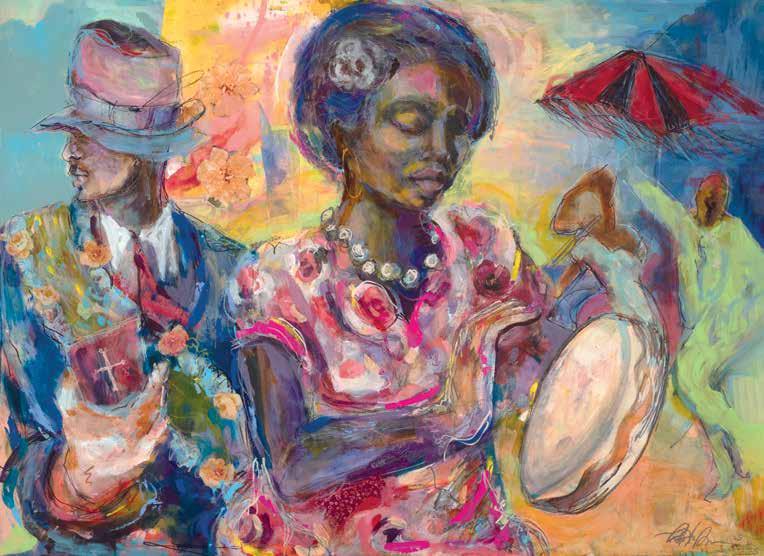
Jan Sound, 2022, mixed media on canvas, 30 x 40 in.
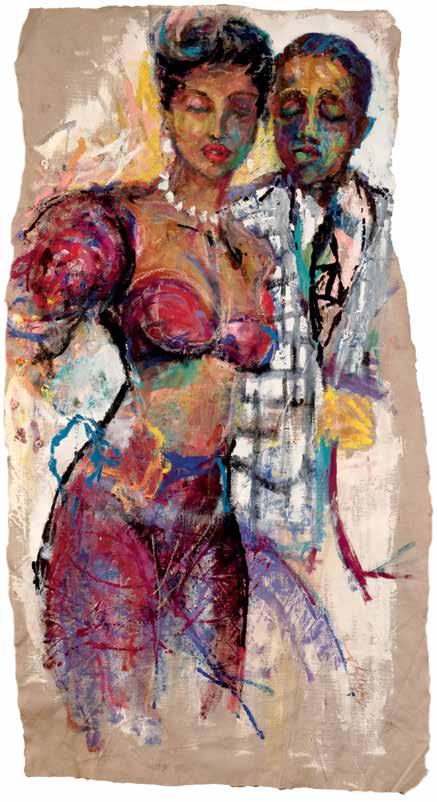
Untitled, n.d., mixed media on linen, 58 x 34½ in., Collection of Gwendolyn Clark
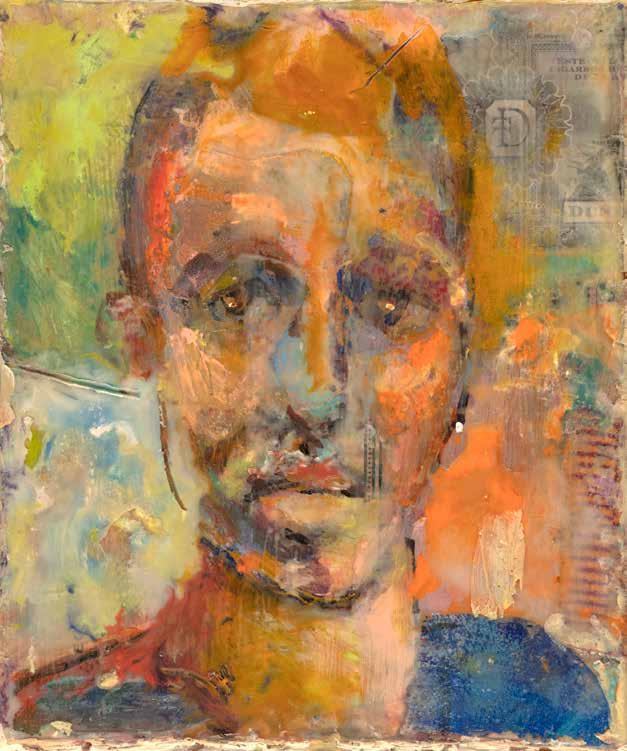
Cabana Boy, 2019, encaustic on wood, 10 x 8½ in., Collection of Eric Key
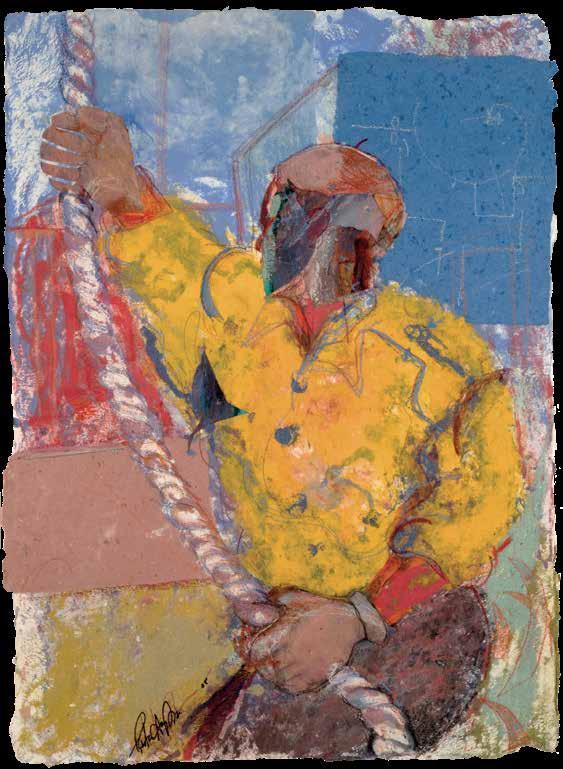
Holding the Line, 2007, mixed-media pulp painting, 30 x 22 in., Collection of George Martin

David, 2016, encaustic on wood, 32 x 25 in., Courtesy of Just Lookin’ Gallery

Daddy’s Girls, n.d., acrylic on linen, 52 x 32 in., Collection of Al and Michaele C. Christian

Generation, 1999, mixed media on canvas, 58 x 40 in., UMGC Permanent Collection, Maryland Artist Collection, Gift of Beverly Corey

Big Top with Natural Crown, 2017–18, mixed media on canvas, 38 x 30 in.
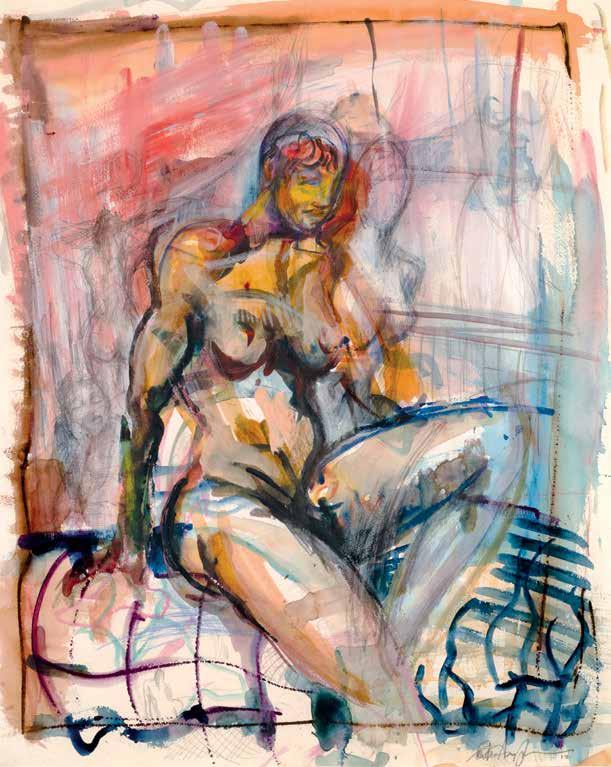
Untitled, 2012, mixed media, 25 x 20 in., Collection of Lola and Bill Keyes

Origin, 1978, oil on canvas, 10½ x 8½ in.
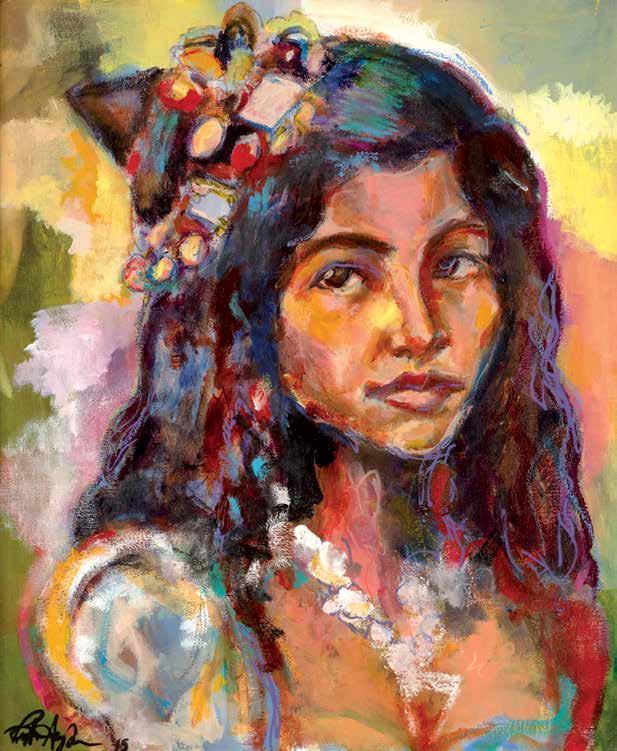
Untitled (Girl), 2015, acrylic on canvas, 29 x 25 in., Collection of Christine Waddler

Untitled (Abstraction), 2024, mixed media on canvas, 48 x 48 in.

Torch Song, 1994, mixed media, 73¾ x 73½ in., Collection of Curtis and Leslie Lewis
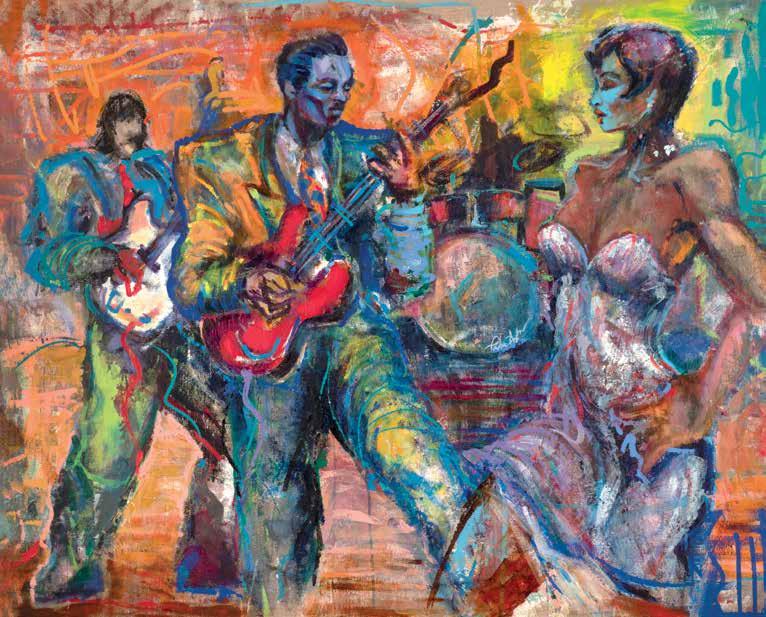
Mojo Queen, 1995, acrylic on linen, 45½ x 55½ in., Collection of Steven L. Yonker
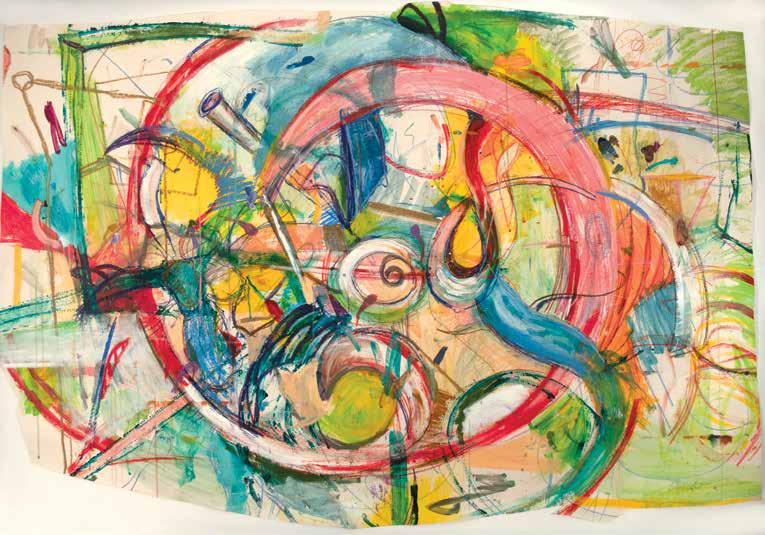
Big Bang, 2005–06, mixed media on paper, 54 x 74 in., Collection of Kathy Lee

Superhero, 2021, acrylic on canvas, 40 x 30 in., Collection of J. R. Clark
Exhibition List
Bearer of Secrets
Documents Please series 2024, pulp-painting collage 34 x 25 in.
Big Bang, 2005–06 mixed media on paper 54 x 74 in.
Collection of Kathy Lee
Big Top with Natural Crown 2017–18, mixed media on canvas 38 x 30 in.
Brothers, 2022 mixed media on canvas 48 x 60 in.
Cabana Boy, 2019 encaustic on wood 10 x 8½ in.
Collection of Eric Key
Chronicle of Morris
Documents Please series 2024, pulp-painting collage 34 x 25 in.
Class, 2024 pulp-painting collage 61 x 33 in.
Collection of Brenda AtkinsonWilloughby
The Craftsman, 2007 etching, 15 x 15 in.
UMGC Permanent Collection
Maryland Artist Collection Produced by Millennium Art Salon Gift of Juanita Boyd Hardy
Created Equal, 2022 hand-embellished digital print 40 x 30 in.
Daddy’s Girls, n.d.
acrylic on linen
52 x 32 in.
Collection of Al and Michaele C. Christian
David, 2016 encaustic on wood 32 x 25 in.
Courtesy of Just Lookin’ Gallery
Dignity, 2024 pulp-painting collage 61 x 33 in.
Documented
Documents Please series 2024, pulp-painting collage 34 x 25 in.
Floral Fantasy, n.d.
acrylic on canvas 16 x 12 in.
Courtesy of Just Lookin’ Gallery
Fork in the Road, 2018 mixed media on paper 41 x 32 in.
Gabriel, 1984 mixed media
50 x 50 in.
Collection of Curtis and Leslie Lewis
Generation, 1999 mixed media on canvas
58 x 40 in.
UMGC Permanent Collection
Maryland Artist Collection Gift of Beverly Corey
Goddess of Mango Season, n.d.
mixed media on canvas
43 x 70 in.
Collection of James and Terri Scott
Golden Child, 2022
acrylic on canvas
40 x 30 in.
Good Counsel, 2012 encaustic on foam board 11 x 11 in.
Graduation Day, 1987
acrylic on canvas 21 x 16 in.
Guardian, n.d. encaustic on wood 12 x 12 in.
Collection of Lynn Sylvester
Hero’s Welcome, 2024 mixed-media pulp painting
23½ x 19 in.
Holding the Line, 2007 mixed-media pulp painting
30 x 22 in.
Collection of George Martin
Jan Sound, 2022 mixed media on canvas
30 x 40 in.
Legacy, 1999–2000
acrylic on linen
90 x 80 in.
Collection of the Washington (DC) Alumni Chapter of Kappa Alpha Psi Fraternity
Lion, 2022 pulp-painting collage
40½ x 23½ in.
Collection of Moses Sawney
Long Game for Morris, 2022 mixed media on canvas
60 x 141 in.
Love Is Everywhere, 2023
mixed-media pulp painting 24 x 32 in.
Collection of Brenda and Larry Thompson
Man in Blue Hat, n.d.
mixed-media pulp painting
38 x 30 in.
Collection of Eileen Berger/ Just Lookin’ Gallery
Man Playing Guitar, 2005
watercolor on pulp paper
41¾ x 49½ in.
Collection of Eric Key
Maroon Devils, 2023–25 mixed media on canvas
90 x 94 in.
Miami Dolphins, 1970s paint on wood
8¾ x 10 in.
Modern Man, 2007
mixed-media collage on paper
30½ x 21½ in.
Collection of Neil and Juanita Hartbarger
Mojo Queen, 1995
acrylic on linen
45½ x 55½ in.
Collection of Steven L. Yonker
Moving Wood, 2006 mixed media on pulp paper
30 x 40 in.
UMGC Permanent Collection
Maryland Artist Collection Gift of the artist
Oh Say Can You See, 2020
acrylic on canvas
40 x 30 in.
Origin, 1978 oil on canvas
10½ x 8½ in.
Patriot Game, 2024 mixed media on paper
41 x 23½ in.
Pink Floyd, 2018
mixed media on paper
50 x 41 in.
Prince of the City, 2019 mixed media on canvas
38 x 26 in.
Collection of Clarence Reynolds
Prodigal Son, 2019
acrylic on canvas
40 x 30 in.
Prodigies, 2005
acrylic on canvas
46 x 70 in.
Collection of Larry Frazier
Repose, 2011
mixed media on pulp paper
22 x 30 in.
Collection of Piero and Christie Novelli
Scribe, 2024 mixed-media pulp painting
32 x 23½ in.
Collection of Stephen Keith/ Courtesy of Just Lookin’ Gallery
Self-Portrait, 1978 gouache on board
193/8 x 67/8 in.
Sunday Best, 1992
acrylic on stretched canvas
38½ x 50¾ in.
The David C. Driskell Center at the University of Maryland, College Park, Gift from the Sandra and Lloyd Baccus Collection, 2012.13.174
Superhero, 2021
acrylic on canvas 40 x 30 in.
Collection of J. R. Clark
Sybil, 2023
pulp painting
45 x 23 in.
Torch Song, 1994 mixed media
73¾ x 73½ in.
Collection of Curtis and Leslie Lewis
Turning Two, 1990
acrylic on linen
44 x 70 in.
Collection of Curtis and Leslie Lewis
Untitled, 2012 mixed media
25 x 20 in.
Collection of Lola and Bill Keyes
Untitled, n.d. mixed media on linen
58 x 34½ in.
Collection of Gwendolyn Clark
Untitled (Abstraction), 2024 mixed media on canvas
48 x 48 in.
Untitled (Baseball Player), 1970s paint on wood 11¾ x 7 in.
Untitled (Girl), 2015
acrylic on canvas
29 x 25 in.
Collection of Christine Waddler
Artist's Biography

Education
1984
Bachelor of Arts, Studio Art, University of Maryland, College Park
Selected Related Experience
2025
Scene Painter, “SNL50: The Anniversary Special,” Saturday Night Live, New York, NY
2023–24
Board Member, Printmaking Legacy Project, Rockville, MD
2009–2013
Adjunct Instructor, Community College of Baltimore County, MD
1990–2001
Art Teacher, District of Columbia Public Schools, Washington, DC
Selected Solo Exhibitions
2024
New Works, New Visions, Just Lookin’ Gallery, Hagerstown, MD
2021
Fibers of Being, Just Lookin’ Gallery, Hagerstown, MD
2020
Respite, Stone Tower Gallery, Glen Echo Park, Glen Echo, MD
2017
White Noise, September Gray Fine Art Gallery, Atlanta, GA
2013
New Directions, Sol Studio, New York, NY
2012
Common Threads, Featherstone Center for the Arts, Oak Bluffs, MA
2011
Common Threads, International Visions Gallery, Washington, DC
2006
Power and Purpose, International Visions Gallery, Washington, DC
2004
Fascinating Rhythms, International Visions Gallery, Washington, DC
1999
Monotypes and Pulp Paintings, U.S. Courthouse, Greenbelt, MD
1997
Explorations and Celebrations, Arts Program Gallery, University of Maryland Global Campus, Adelphi, MD
1996
Reminiscing, Camille Love Gallery, Atlanta, GA
1993
Remembrance: Negro League Baseball, Charles Sumner School Museum and Archives, Washington, DC
Selected Group Exhibitions
2025
With Passion and Purpose: Gifts from the Collection of Larry D. and Brenda A. Thompson, National Gallery of Art, Washington, DC
Works on Paper, Brooklyn Fine Art Print Fair, New York, NY
2024
Eternal Paper, Arts Program Gallery, University of Maryland Global Campus, Adelphi, MD, and the Paper Academy, Copenhagen, Denmark
Art Is a Form of Freedom, Georgia Museum of Art, University of Georgia, Athens, GA
Decadence of Another Kind, Bridgeport Art Center, Chicago, IL
2022
1-54 Contemporary African Art Fair, Long Gallery, New York, NY
Visible Man: Art and Black Male Subjectivity, Fine Arts Center Galleries, Bowling Green State University, Bowling Green, OH, and Harvey B. Gantt Center for African-American Arts and Culture, Charlotte, NC
2021
Brave Spaces: Resilience and Healing, Sebrof Forbes Cultural Arts Center, Kensington, MD
David C. Driskell’s Students, David C. Driskell Center, University of Maryland, College Park, MD
Black and Blue: Prints in the Time of COVID, Gallery Myrtis, Baltimore, MD
2020
The Story of Our Skin, Montpelier Arts Center, Laurel, MD
2019
The Blues and the Abstract Truth: Voices of African American Art, Washington County Museum of Fine Arts, Hagerstown, MD
400 Years: Journey of the Diaspora 1619–2019, Prince George’s African American Museum and Cultural Center, Brentwood, MD
Sundry Souls, Black History Museum and Cultural Center of Virginia and Walton Gallery, Richmond, VA
2018
Resist, Zenith Gallery, Washington, DC
Scope International Contemporary Art Show, Miami, FL
Elements that Define Us, Prince George’s African American Museum and Cultural Center, Brentwood, MD
It’s About That Time: Ten Years of Lily Prints, DC Arts Center, Washington, DC
2017
Tradition Redefined: The Larry and Brenda Thompson Collection of African American Art, Georgia Museum of Art, University of Georgia, Athens, GA
2016
Fabriano Watercolour 2016, Fabriano, Italy
Movers and Shakers: Ibou N’Diaye and Preston Sampson, Zenith Gallery, Washington, DC
It Takes a Nation: Art for Social Justice, American University Museum at the Katzen Arts Center, Washington, DC
2013
Convergence: Jazz, Films, and the Visual Arts, David C. Driskell Center, University of Maryland, College Park, MD, and American Jazz Museum, Kansas City, MO
Royal Blues Line: DC to NY, William Jennings Gallery at Kenkeleba, New York, NY
2012
Collectors View 2012: Private Collections of Contemporary Visual Art, Transformer Gallery, Washington, DC
By Special Request, Diggs Gallery, Winston-Salem State University, Winston-Salem, NC
2011
The Art of Giving Back, Visual Arts Gallery, School of Visual Arts, New York, NY
2008
Highlights from the David C. Driskell Center Permanent Collection, David C. Driskell Center, University of Maryland, College Park, MD
Reflective Interludes, Ratner Museum, Bethesda, MD
2007
Dialogue with Color: Kevin Cole and Preston Sampson, Whitespace Gallery, Winston-Salem, NC
Continuum: Innovative Prints from 1997 to 2007, Pyramid Atlantic Arts Center, Silver Spring, MD
2006
Color, Sense, and Sequence: Preston Sampson, Susan Goldman, and Kevin Cole, Legacy Fine Art Group, Bethesda, MD
2005
Collaboration as a Medium: 25 Years of Pyramid Atlantic, Edison Place Gallery, Washington, DC, and Maryland Art Place, Baltimore, MD
2004
On Common Ground: Two- and Three-Dimensional Art—Paintings, Photography, and Sculpture, Millennium Arts Salon, Washington, DC
2002
Successions: Prints by African American Artists from the Jean and Robert Steele Collection, Art Gallery, University of Maryland, College Park, MD
Rhythm & Blues: Preston Sampson and Kevin Cole, Sandler Hudson Gallery, Atlanta, GA
2001
CrossCurrents 2001: The Works of Pyramid Atlantic, Art Gallery, University of Maryland, College Park, MD
Selected Public and Private Collections
African American Museum, Dallas, TX
Bureau of Cultural Affairs, City of Atlanta, Georgia
Peggy Cooper Cafritz, Washington, DC
Cultural Council for Palm Beach County, Lake Worth Beach, FL
David C. Driskell Center, University of Maryland, College Park, MD
DC Commission on the Arts and Humanities, Washington, DC
Duke Ellington School of the Arts, Washington, DC
Hampton University Museum, Hampton, VA
Larry and Brenda Thompson Permanent Collection, Georgia Museum of Art, University of Georgia, Athens, GA
Library of Congress, Washington, DC
Morehouse School of Medicine, Atlanta, GA
Paper and Watermark Museum, Fabriano, Italy
National Education Association, Washington, DC
National Gallery of Art, Washington, DC
National Museum of African American Music, Nashville, TN
Paul R. Jones Museum, University of Alabama, Tuscaloosa, AL
PBS-MPTV, Owings Mills, MD
Spritmuseum, Stockholm, Sweden
University Libraries, University of Colorado Boulder, Boulder, CO
Darrell Walker, Arkansas
Walter E. Washington Convention Center, Washington DC
Ronald W. and Patricia Walters, Washington, DC
Xfinity Center, University of Maryland, College Park, MD
Yale University Art Gallery, New Haven, CT
Selected Public Installations
2022
St. Elizabeth’s East Campus Men’s Shelter, Washington, DC
2021
Benjamin Banneker Academic High School, Washington, DC
National Museum of African American Music, Nashville, TN
2019
Modern Woodmen Park, Davenport, IA
2017
Ron Brown College Preparatory High School, Washington, DC
2015
Walter E. Washington Convention Center, Washington, DC
2014
Xfinity Center, University of Maryland, College Park, MD
Coleman Park (formerly Lincoln Park), West Palm Beach, FL
Selected Panel Discussions and Lectures
2023
“Black Artists in Dialogue,” 33rd James A. Porter Colloquium on African American Art and Art of the African Diaspora, Howard University, Washington, DC
2019
Discussion, Mosaic Theater and Millennium Arts Salon, in conjunction with Twisted Melodies: A Day in the Life of Donny Hathaway, Washington, DC
2017
Artist Panel Discussion, The Last Ten Years: In Focus, David C. Driskell Center, University of Maryland, College Park, MD
Panel Discussion, Tradition Redefined: The Larry and Brenda Thompson Collection of African American Art, Georgia Museum of Art, University of Georgia, Athens, GA
2013
Panel Discussion, Visions of Our 44th President, Charles H. Wright Museum of African American History, Detroit, MI
2011
Panel Discussion, Tradition Redefined: The Larry and Brenda Thompson Collection of African American Art, David C. Driskell Center, University of Maryland, College Park, MD
Selected Residencies and Workshops
2023
Painting Lecture and Critique, Department of Art, Howard University, Washington, DC
2019
“The Courage Within Me” Project with Michelle Angela Ortiz, The REACH at the John F. Kennedy Center for the Performing Arts, Washington, DC
2018
Artist in Residence, Graham Park Middle School, Triangle, VA
2010
Pulp Painting Symposium, Southwest School of Art, San Antonio, TX
2006
Arts and Education Program, in conjunction with William T. Williams: Variations on Themes, David C. Driskell Center, University of Maryland, College Park, MD
2002
Artist in Residence, Prince William County Public Schools, VA
ArtsWorks Program, Designs in Glass Bus Shelter Project, Arlington County Cultural Affairs, VA
Selected Reviews and Publications
Lynn Sures and Michelle Samour, Radical Paper: Art and Invention with Colored Pulp (Legacy Press, 2024).
Michael Hodges, “44: Portraits of a President at Charles H. Wright Museum of African American History,” Detroit Art Review, June 5, 2022.
Cheryl Edwards, “Contemporary Artist: Preston Sampson,” Hand Papermaking (Summer 2021).
Alicia Notarianni, “Just Lookin’ Exhibit Explores Challenge of Change,” Herald-Mail, September 26, 2020.
Cecilia Markley, “Local Artists Use Their Work as a Form of Protest,” The Eagle (American University), July 14, 2020.
Steve Batterson, “Modern Woodmen Park’s New Artwork Shares the Spirit of the Quad-Cities,” Quad-Cities Times, June 15, 2019.
Mark Jenkins, “Movers and Shakers,” Washington Post, September 9, 2016.
Adrienne L. Childs, “Imagining Obama: The Art of the First Black President,” Politico Magazine, January/February 2016.
Karen Dybis, “A Trip to Detroit’s Charles H. Wright Museum Delights with New Exhibits, Fresh Ideas, New Hope,” Detroit Hub, January 25, 2013.
Jerry Langley, "In the Line of Duty: Police Chief William C. Robinson, Collecting and Promoting African American Art," International Review of African American Art 24, no. 1 (2012).
Mark Jenkins, “A Day’s Work,” Washington Post, July 15, 2011.
Tom Patterson, “New Space, New Faces: Artist from Washington and Atlanta Showing Unusual Works at Gallery in Downtown Loft,” Winston-Salem Journal, March 18, 2007.
Lisa Mowry, “Where the Art Is,” Better Homes and Gardens: Bedroom & Bath (Summer 2002).
Wayne Savage, “A Stroke of Genius: Painter Shares Hue-Mongous Talents with County Schools and Arts Center,” Prince George’s County Gazette, May 20, 1999.
Ferdinand Protzman, “Critical Discoveries,” Washington Post, August 6, 1998.
Jerry L. Langley and Juliette Bowles, eds., “A Comprehensive Guide to African American Art,” special issue, International Review of African American Art (1998).
Gary Schwan, “Preston Sampson: An Artist on the Rise,” Palm Beach Post, October 5, 1997.
Ferdinand Protzman, “The Strength of Sampson,” Washington Post, February 22, 1997.
About UMGC
University of Maryland Global Campus was founded more than 75 years ago specifically to serve the higher education needs of working adults and military servicemembers. Today, UMGC is the largest provider of postsecondary education in Maryland and continues its global tradition with online and hybrid courses, more than 175 classroom and service locations worldwide, and more than 135 degrees and certificates backed by the reputation of a state university and the University System of Maryland. For more information, visit umgc.edu.
About the Arts Program at UMGC
Since 1978, UMGC has proudly shown works from a large collection of international and Maryland artists at its headquarters in Adelphi, Maryland, a few miles from the nation’s capital. Through its Arts Program, the university provides a prestigious and wide-ranging forum for emerging and established artists and brings art to the community through special exhibitions and its own collections, which have grown to include more than 2,900 pieces of art.
Artworks are on display throughout the College Park Marriott Hotel & Conference Center and the Administration Building in Adelphi. The main, lower-level gallery in Adelphi is open to the public from 9 a.m. to 9 p.m. seven days a week, and the Leroy Merritt Center for the Art of Joseph Sheppard is open to the public from 9 a.m. to 7 p.m. seven days a week. More than 75,000 students, scholars, and visitors come to the Adelphi facilities each year.
Arts Program Mission Statement
The UMGC Arts Program is dedicated to furthering the university’s objectives by creating a dynamic environment in which our diverse constituents, including students and the general public, can study and learn from direct exposure to our art collections, exhibitions, and educational programs.
Contributors
Director, Arts Program: Eric Key
Curator: Treston Sanders
Editors: Sandy Bernstein, Beth Butler, Barbara Reed
Senior Web and Graphic Design Manager: Olya Kalatsei
Senior Web and Graphic Designer: Jennifer Norris
Senior Account Manager: Laurie Bushkoff
Print Production and Vendor Relations Manager: Scott Eury
Fine Arts Technician: René A. Sanjines
Administrative Assistant: Tawanna Manago
Artwork photography by Greg Staley unless noted otherwise.
Cover artwork:
Front: Generation, 1999, mixed media on canvas, 58 x 40 in. UMGC Permanent Collection, Maryland Artist Collection, Gift of Beverly Corey
Back: Floral Fantasy, n.d., acrylic on canvas, 16 x 12 in. Courtesy of Just Lookin’ Gallery
Catalog published in conjunction with the exhibition
Preston Sampson: Letters From Home UMGC Arts Program Gallery July 27–October 19, 2025
© 2025 University of Maryland Global Campus. All rights reserved. Copyright credits and attribution for certain illustrations are cited internally proximate to the illustrations.
ISBN: 13:978-0-9842265-0-4
ISBN: 10:0-98442265-0-8
3501 University Boulevard East
Adelphi, MD 20783-8000 USA
umgc.edu/art

